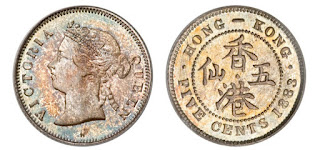The name of the territory, was first romanised as ''He-Ong-Kong in 1780, originally referred to a small inlet located between Aberdeen Island and the southern coast of Hong Kong Island. This is believed to be an early phonetic rendering of the Cantonese pronunciation ''heung gong'' or Tanka Cantonese. The name translates as ''fragrant harbour'' or ''incense harbour''. The simplified name of Hong Kong was frequently used by in 1810.
Hong Kong, 5 Cents, 1883.
Hong Kong was established as a colony of the British Empire after the Qing Empire ceded Hong Kong Island from Xinán County at the end of the First Opium War in 1841, then again in 1842. The colony expanded to the Kowloon Peninsula in 1860 after the Second Opium War and was further extended when Britain obtained a 99-year lease of the New Territories in 1898.
Map showing Hong Kong
Emblem
British Hong Kong was occupied by Imperial Japan from 1941 to 1945 during World War II, British administration resumed after the surrender of Japan.
British Hong Kong Flag from 1959 to 1997
The complete territory was transferred to China in 1997. As one of China's two special administrative regions (the other being Macau), Hong Kong maintains separate governing and economic systems from that of mainland China under the principle of ''one country, two systems''. Officially known as the Hong Kong Special Administrative Region of the People's Republic of China (HKSAR), it has over 7.5 million residents in a 1,104 square kilometer (426 square miles) territory and is one of the most densely populated places in the world.
Hong Kong Island skyline from Victoria Harbour waterfront
Originally a sparsely populated area of farming and fishing villages, the territory has become one of the world's most significant financial centers and commercial ports. Hong Kong has a major capitalist service economy characterised by low taxation and free trade, and its currency, the Hong Kong dollar. is the eighth most traded currency in the world. Hong Kong is home to the third-highest billionaires of any city in the world.
Hong Kong in 1868, photo by John Thompson
The name was commonly written as a single word Hongkong until 1926, when the government officially adopted the two-word name. The Ethnic groups include 92% Han Chinese, 2.5% Filipino. 2.1 % Indonesians, 0.8% white, 0.5% Indian, 0.3% Nepalese and 1.6% Others.
Satellite image of Hong Kong
Hong Kong is a highly developed territory and ranks fourth on the UN Human Development Index. The territory is divided into 18 districts, each represented by a district council, who advises the government on local issues.
Administrative Divisions
5 Cents, Edward VII, 1903-1905, silver. weight 1.3 gm,
10 Cents, George V, 1935-1936, copper-nickel, weight 2.6 gm
20 Cents, Edward VII, silver, weight 5.4 gm
50 Cents, George VI, 1951, Copper-nickel, weight 5.8 gm
5 Dollars, Elizabeth II, 1976-1979, Copper-nickel, weight 10.7gm






















No comments:
Post a Comment
Any inputs or feedback is welcome!